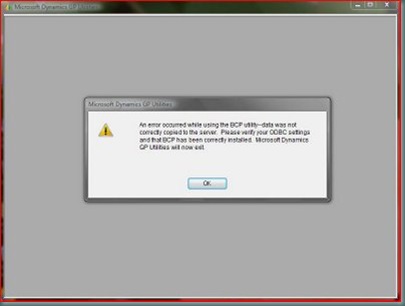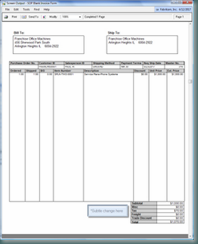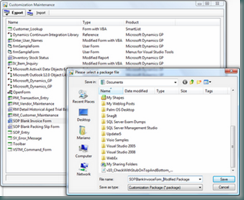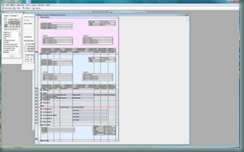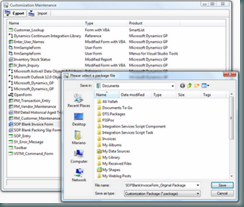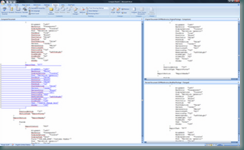To copy Microsoft Dynamics GP setup from company to another company DTS the following tables via SQL
Finance
GL00100 Chart of Accounts
Note Do not copy the GL00101
GL00102 Account Category Master
GL00103 Fixed Allocation Accounts
GL00104 Variable Allocation Accounts
GL00105 Account Index Master
CM00100 Checkbook Master
CM40100 Cash Management Setup
CM40101 Cash Management Transaction Type Setup
GL00200 Budget Master file
GL00201 Budget Master file
GL40000 General Ledger Setup
GL40100 Quick Journal Setup
GL40101 Quick Journal Setup
GL40200 Segment Description Master
SY04100 Bank Master
MC40000 Multicurrency Setup
MC40100 Multicurrency Setup
ASI*.* Advanced Lookup Files
Purchase
PM00100 PM Class Master
PM00101 Vendor Class Accounts
PM00200 Vendor Master
PM00203 Vendor Accounts
PM00300 Address Master
PM40100 PM Setup File
PM40101 PM Setup File
PM40102 PM Setup File
PM40103 PM Setup File
POP00101 Buyer Master
POP40100 Purchasing Setup File
POP40600 Purchasing Non-IV Item Currency Setup
ASI*.* Advanced Lookup Files
Sales
IVC40100 Invoicing Setup
IVC40101 Invoicing Setup
RM00101 Customer Master
RM00102 Customer Master Address
RM00105 National Accounts Master
RM00201 Class Master
RM00301 Salesperson Master files
RM00303 Sales Territory Master
RM40101 RM Setup
RM40201 RM Period Setup
RM40401 RM Document Type Setup
SOP00100 Process Holds Master
SOP00200 Prospect Master
SOP40100 Sales Setup
SOP40200 Type ID setup
SOP40201 Default Process Holds Setup
SOP40300 Document Setup
SOP40400 User Defined Table Setup
SOP40500 Master Number Setup
SOP40600 Non-IV Item Currency Setup
ASI*.* Advanced Lookup Files
Inventory
BM00101 Bill of Materials Header
BM00111 Bill of Materials Component
BM40100 Bill of Materials Setup
IV00101 Item Master
IV00102 Item Quantity Master
IV00103 Vendor Master
IV00104 Kit Master
IV00105 Item Currency Master
IV00106 Item Purchasing
IV00107 Item Price List Options
IV00108 Item Price List
IV00109 Item Serial Number Mask
IV40100 Inventory Control Setup
IV40201 U of M Setup
IV40202 U of M Setup
IV40400 Item Class Setup
IV40401 Item Class Currency Setup
IV40500 Item Lot Category Setup
IV40600 Item Category Setup
IV40700 Item Site Setup
IV40800 Price Level Setup Company Folder
IV40900 Price Group Master
IV41000 Stock Calendar
IV41001 Stock Calendar Exception Days
ASI*.* Advanced Lookup Files
Company
SY00300 Account Format Setup
SY01100 Posting Account Master
SY02200 Posting Journal Destinations
SY02300 Posting Setup
SY03000 Shipping Methods
SY03100 Credit Card Setup
SY03300 Payment Terms Setup
SY40100 Fiscal Period Setup
SY40101 Fiscal Period Setup
TX00101 Tax Schedule Header Master
TX00102 Tax Schedule Master
TX00201 Tax Master
STN*.* Named Printers Setup
ASI*.* Dynamics Explorer Files
U.S. Payroll
When you copy payroll setup information from one company to another company,
the following setup tables are used:
UPR40100 Payroll Unemployment Setup
UPR40101 Payroll Unemployment TSA
UPR40200 SetupUPR40300 Department Setup
UPR40301 Job Title Setup
UPR40500 Accounts Setup
UPR40501 Tax Expense/Withholding Setup
UPR40600 Pay Code Setup
UPR40700 Workers Comp Setup
UPR40800 Benefit Setup
UPR40801 Benefit Based On Setup
UPR40900 Deduction Setup
UPR40901 Deduction Based On Setup
UPR40902 Deduction Sequence Setup
UPR41100 State Code Setup
UPR41200 Class Setup
UPR41201 Class Detail Setup
UPR41400 Local Tax Setup
UPR41401 Local Tax Table Setup
UPR41500 Shift Code Setup
UPR41700 Supervisor Setup
UPR41800 Payroll Maximum Deduction Setup (only in Microsoft Dynamics GP 10.0)
UPR41801 Payroll State/Fed Setup (only in Microsoft Dynamics GP 10.0)
UPR41900 Payroll Earnings Setup (only in Microsoft Dynamics GP 10.0)
UPR41901 Payroll Earnings Paycode (only in Microsoft Dynamics GP 10.0)
UPR41902 Payroll Earnings Deductions (only in Microsoft Dynamics GP 10.0)
Note If you copy the UPR40500 file, the posting accounts will be identical
to those of the company that you are copying.
Payroll Extensions (deduction in arrears, payables integration to payroll,
overtime rate manager)
ORM_UPR_SETP_OT_DTL
ORM_UPR_SETP_OT_HDR
UPR40600_OT
APR_DIA40100
APR_DIA40200
APR_UPR40500
APR_UPR40900
APR_PIP40100
Advanced Payroll
APR40600
APR41100
APR41101
APR41501
APR41601
APR_APR70901
APR_APR70900
APR_UPR40500
APR_APR40101
APR_APR40100
Canadian Payroll
CPY10010 CDN Payroll Employer Master
CPY10020 CDN Payroll Department Master
CPY10030 CDN Payroll Employee Job Titles
CPY10050 CDN Payroll Employee Class
CPY10051 CDN Payroll Class Attached Pay codes File
CPY10060 CDN Payroll Pay code Master
CPY10061 CDN Payroll Pay code Attached Pay codes
CPY10062 CDN Payroll Income Attached Pay Codes
CPY10063 CDN Payroll Rate Table Codes
CPY10064 CDN Payroll Rate Tables
CPY10070 CDN Payroll WCB Master
CPY10075 CDN Payroll WCB Administration
CPY10080 CDN Payroll User Paid By
CPY10081 CDN Payroll User Drop Down Strings
CPY10082 CDN Payroll Reporting Codes
CPY10170 CDN Payroll Employee Unions
CPY10171 CDN Payroll UnionAttached Pay codes
CPY20200 CDN Payroll Job Master
CPY20201 CDN Payroll Phase Master
CPY20700 P_Security_Group_MSTR
CPY20705 P_Security_Group_Detail
CPY20710 P_Security_User_MSTR
If the following information is the same, you can also copy these files:
CPY20100 CDN Payroll Control Master
CPY20110 CDN Payroll CSB Setup Information
CPY20111 CDN Payroll CSB Pay codes
Human Resource
BE020230 HR_Benefit_SETP
BE021030 BEN2_FMLA_Line
BE031000 BEN_FMLA_INFO
HR2Ben21 HR_Benefit_Tiers_SETP
HR2Ben11 HR_Benefit_Fund
HR2Ben12 HR_Benefit_MDVE_Table
HR2Ben13 HR_Benefit_Life_Premiums
HR2Ben14 HR_Venefit_MDVE_Types
HR2Div02 HR_Division2
HR2Tra01 HR_Train_Course
HR2Tra03 HR_Train_Class
HRCom022 HR_Company2_extra
HRDep022 HR_Department2_Extra
HRDiv022 HR_Division2_Extra
HRPBen05 HRP_BEN_FMLA_Set12Month
HRPro022 HR_Property
HRPppc01 HRP_Position_Pay_Code
HRsax012 HR_Salary_Matrix
HRsax022 HR_Salary_Matrix_Table
HRsax042 HR_Salary_Matrix_Col
HRsax032 HR Salary Matrix rows
HRtra042 HR_Train_Class_Skills
HRtrpc02 HR_Train_Position_Course_Class
HRtrps01 HR_Train_Position_Course
RV010221 HR_Review_LINE_V2
RV020221 HR_Review_Setup_LINE_V2
RV030221 HR_Review_Words_Setup_LINE
SK010230 HR_Skills_Line
TAAC0130 TA_SETP_Accrual_Type
TAPY0130 TA_Payroll_Link
Note The TAPY0130 TA_Payroll_Link table was removed in Microsoft Dynamics GP
9.0 and in Microsoft Dynamics GP 10.0.
TAST0130 TA_Setup
TAST0230 TA_Attendance_reason
TAST0330 TA_Attendance_Types
TAST0532 TA_Pay_Period_accrual_LINE
TATM0130 TA_SETP_Types
Advanced Human Resource
APR_BLM41500
APR_BLM41501
APR_BLM41600
APR_BLM41601
APR_BLM41400
APR_BLM41401
APR_BLM41100
APR_BLM41101
APR_BLM41300
APR_BLM41301
APR_BLM41200
APR_BLM41201
APR_BLM42100
APR_BLM42101
APR_BLM42200
APR_BLM42201
APR_BLM43100
APR_BLM43200
APR_BLM43201
APR_BLM43300
APR_BLM43301
APR_APR40500
EHW40100
EHW40201
EHW40200
EHW40300
EHW40400
EHW40501
EHW40500
CLM40100
CLM40300
CLM40700
CLM40701
CLM40600
CLM40500
CLM40400
CLM40200
PTO Manager
PTO40100
PTO40101
PTO40200
PTO40201
Posted Orginally by MicrosoftSlave in Microsoft Dynamics Forum.
Regards,
--
Mohammad R. Daoud
MCP, MCBMSP, MCTS, MCBMSS
Software Development Manager
+962 - 79 - 999 65 85
Dynamics Innovations
daoudm@dynamicsinnovations.comhttp://www.dynamicsinnovations.com/
